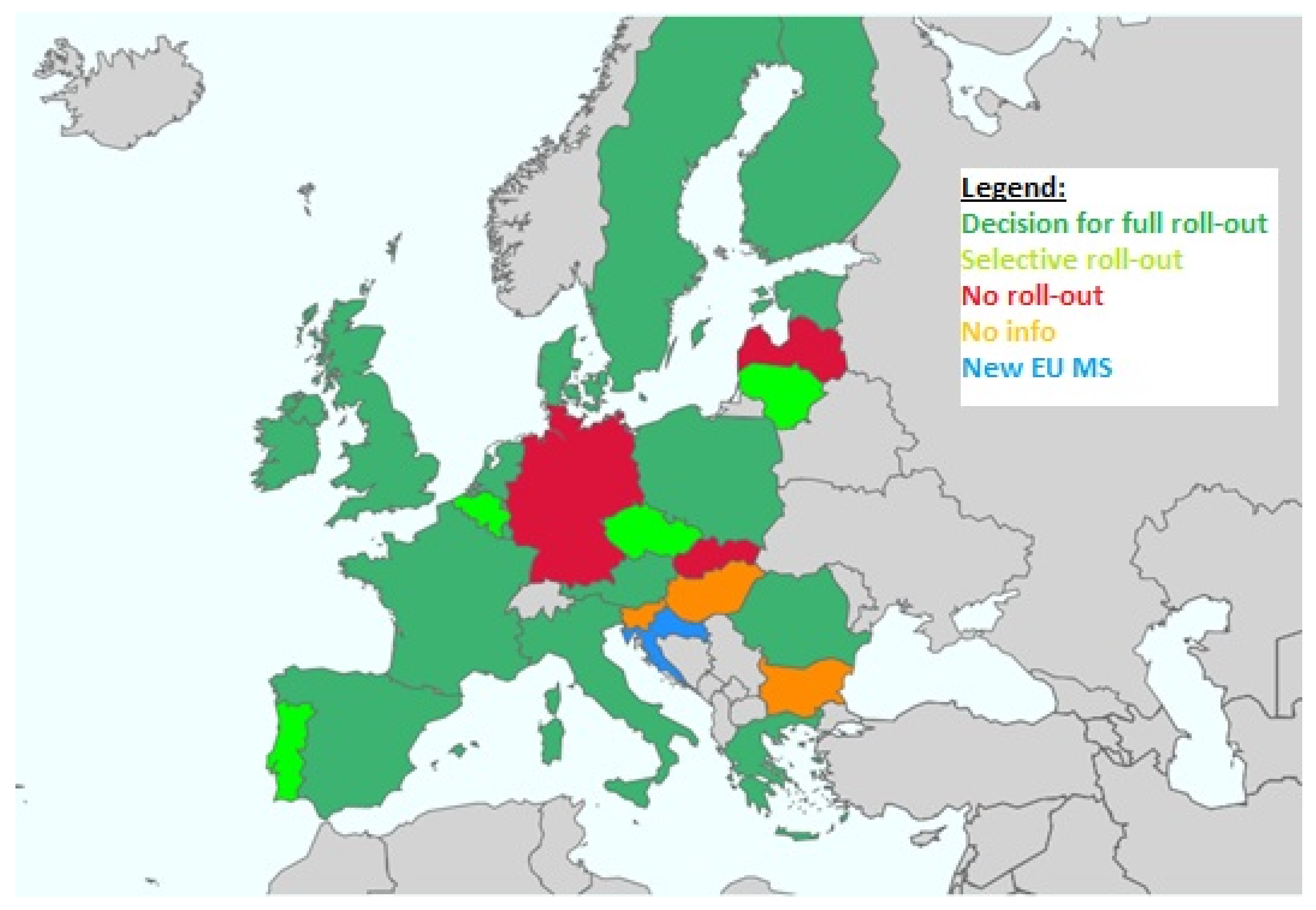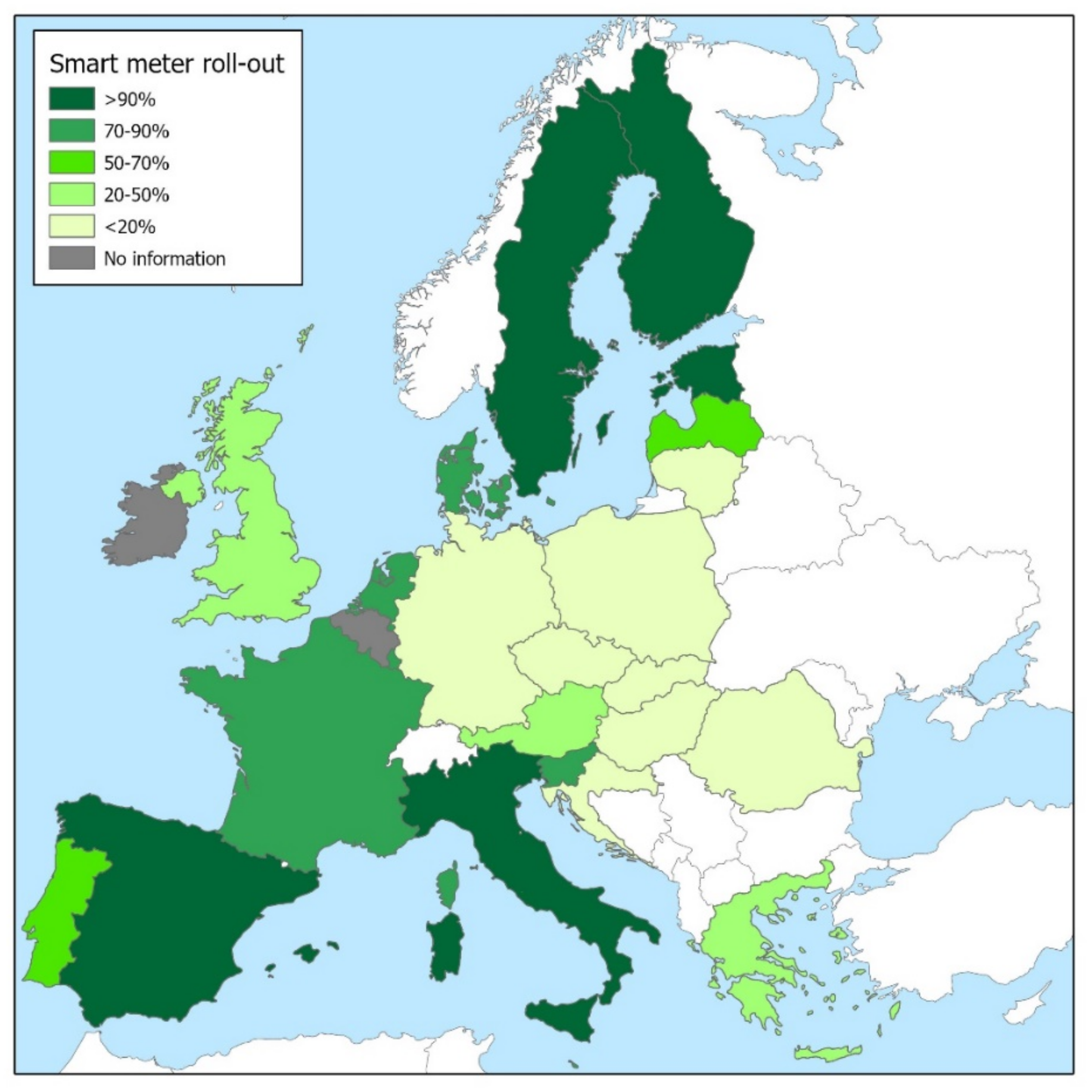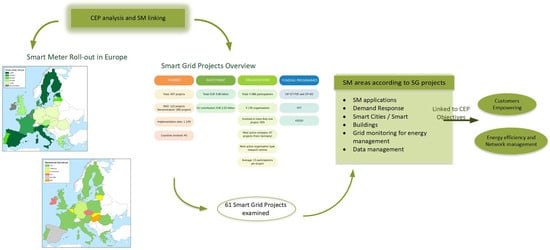5.1. Smart Grid Projects in Europe
Over recent years, there have been many investments in smart grid R&I projects. They have been analyzed in the Smart Grid Projects Outlook [
6], where the smart grid projects with at least one European partner have been listed and described. This has been a periodic exercise carried out by our team. In fact, the report in [
6] has been a follow-up of the equivalent published in 2014 [
11]. A later update of this exercise has been published in late 2021, entitled: “Smart Grids and Beyond: An EU research and innovation perspective” [
12].
According to [
12], there are 407 smart grid projects realized or ongoing in Europe with total investments that reach 3.08 billion euros, whereas there are 5986 organizations involved.
The distribution of the projects throughout Europe is shown in
Figure 5. With red dots, the demonstration projects are visible, whereas with green dots, the research and development projects are visible.
With the use of [
6,
12] and the online options available, we are able to obtain information about smart grid projects and their topic of investigation. In this section, we give an idea of the research performed with respect to smart meters and their applications and the way this research has been evolved over the recent years; thus, showing the trends in the field.
The trends in smart meter research are closely related to the smart meter national roll-outs. Therefore, it is interesting to see the correlation of such research with the latest updates regarding the national roll-outs, as these are presented in
Section 2. The most recently published report on the European smart grid projects shows information about the categories of such projects. These categories are namely [
12]:
Smart Network Management;
Demand Side Management;
Integration of distributed generation and storage;
Integration of large-scale RESs and storage;
Smart City;
E-mobility.
The first two categories are directly linked with smart meters installation, whereas smart city category smart projects can also be linked to smart meters deployment. According to [
12] there are 162 projects related to Demand Side Management, which gather 22.41% of the total funding. On the other hand, there are 65 projects related to Smart Network Management, gathering 16.78% of the total budget. For smart cities, the equivalent numbers are 23 projects and 19.33% of the total budget. As it can be concluded from the numbers, the progress made with respect to national smart meter roll-outs, as this is described in
Section 2, has proved to be fruitful in the sense that numerous projects and investments have been based on wide-scale smart meters implementation. In the following, we give details about projects involving smart meters implementation. The distinction before and after 2014 is related to the timing of the first benchmarking of cost–benefit analyses being published.
5.3. Projects Dealing with Smart Metering Applications—After 2014
One of the tools available along with the Smart Grid Project Outlook 2017 gives the possibility to categorize the projects according to their topic of research. However, as it is mentioned in the report itself, the smart meter domain is not included in the database, since in many Member States, smart metering installations have accomplished a mature level. Nevertheless, it is worth surveying the level of smart meter penetration in Europe and the development of smart grid projects can give us a hint on this direction.
In total, 206 new smart grid projects have been initiated after 2014 and many of them examine smart metering applications. In addition, there are many projects that are based on the analysis of smart meter/smart grid data and propose techniques to improve the supporting networks and ways to handle the amount of data more effectively. Here, we provide some hints on the projects that:
Explicitly mention the utilization of smart meters;
Explicitly mention the utilization of smart meter data;
Refer to applications where smart meters would be key elements for their successful implementation;
The added value of this work is that we provide information about the smart metering applications status regarding the smart grid projects, which is not explicitly mentioned in the Smart Grid Projects Outlook. This information can give feedback on the maturity of the technologies with respect to smart metering applications. Furthermore, the usefulness of the smart meters is highlighted, and it stressed the importance of smart meters for the transition into the smart grid. Such information, along with the benchmarking of smart meter roll-out can give us an idea of how close we are to actually realizing the smart grid applications that will help in the energy transition.
At this point, we give a short description of the smart grid projects that deal with smart meters (smart meters implementation, smart meters playing a key role in local energy communities, etc.). As it can be seen, there are 61 projects that are relevant to smart metering applications. It should be noticed that the list is not exhaustive; more projects are likely to be dealing with smart metering issues or to be based on smart metering applications. In this work, we list the ones that were easier from their description found in [
13] to deduce such information. The following tables show a short description of the projects and a categorization according to their topic. It should be noted that the categorization is indicative; some projects may handle issues with respect to more than one category. The categories chosen for the projects are derived as follows:
Smart metering applications—projects that deal with the smart meters implementation or development of different smart meter features for advanced services;
Demand Response (DR) applications—projects that deal mainly with the facilitation of DR and are based on smart meter usage;
Smart cities/smart home/smart building development—projects that deal with one of these topics either focusing on the consumer part (consumer involvement) or the network part (management of a smart city district or building);
Grid monitoring applications—projects that deal with grid management/grid monitoring issues and smart meter usage can facilitate this goal;
Data management issues—projects that deal with techniques related to data traffic management, like the increased traffic of data created by the implementation of smart meters;
Other applications—we have identified projects that deal with EV charging issues and cyber security issues.
As it can be observed from
Table 5, for the projects described here, smart meters are a fundamental part of each project. Specifically for one project (FLEXMETER), new smart meters are developed for the project’s needs.
As it can be concluded from
Table 6, there are a lot of projects that use smart meter data to implement demand response services. It is obvious that smart meters can facilitate demand response and determine the flexibility of consumers. For many of these projects, smart meters are an important element for the project’s execution.
From
Table 7 it is observed that smart meters can be a pillar for smart buildings and smart cities. They can help in measuring and monitoring the consumptions, thus improving the system’s management.
As it can be observed from
Table 8, smart meters can contribute to data collection, and they can facilitate network management, whereas they play a fundamental role in many projects since they facilitate grid monitoring. Network automatization is also an action that can be facilitated through smart meters.
Table 9 summarizes the projects that deal with data traffic. Smart meters are responsible for a huge amount of traffic created in the network. It is obvious that there are projects that deal with how to handle the traffic created from a large-scale smart meter implementation, implying that there are supporting technologies and techniques for a potential roll-out.
Table 10 summarizes the usage of smart meters in other fields, like EV charging and cyber security issues, showing that the benefits from smart meters can be visible to multiple fields in the smart grid domain.
As it can be observed from
Table 5,
Table 6,
Table 7,
Table 8,
Table 9 and
Table 10, there are at least (the list is not exhaustive) 7 projects (11%) that deal with smart metering applications (development of smart meters with advanced characteristics or implementation of smart meters), 17 projects (28%) that deal with demand response or flexibility issues, 13 projects (21%) that examine smart home/building or smart neighborhood issues, 14 projects (23%) for grid monitoring, 7 projects (11%) that examine data management issues, 1 project studying cyber security in smart meters.
From the analysis made, some conclusions about the smart grid research trends can be concluded. For example, it is observed that the interest in grid monitoring and grid management remains a high priority for smart grid projects; for such purposes, smart meters can play a key role, since they can offer data about the grid consumption. Smart home/building and smart cities are also a topic on which smart meters can be of vital importance since it is an element that can contribute to the home–smart home transformation. It is worth noticing that DR is a topic that becomes popular lately and this is depicted by the number of projects that deal with it. There have been at least 17 projects initiated in the period 2014–2017, which shows a trend towards the investigation of demand response or flexibility aspects. Another topic that is also gaining attention is data traffic management. This can be explained because smart meters have already been implemented in some member states, thus issues following this vast implementation have come out. Indeed, smart meters are responsible for a massive amount of data communicated through the smart grid; therefore, studies related to data handling are necessary.
In general, the trend from the smart grid projects not only shows the importance of smart meters as a fundamental element of the smart grid, but also suggests the development of integration of solutions going beyond the smart meter as a simple device. These technologies make use of smart meters, build upon the metering infrastructure and explore further their potentials to offer advanced services, like demand response or grid management. The smart grid projects trend shows that the scientific interest gets to be shifted to applications that take for granted the usage of smart meters. Consequently, it is evident the necessity of smart meters implementation in order to make use of advanced applications.












